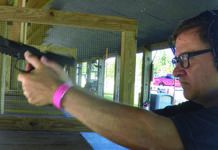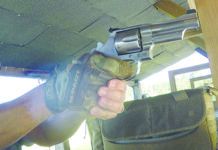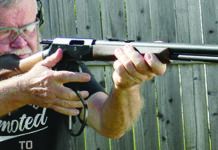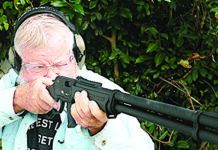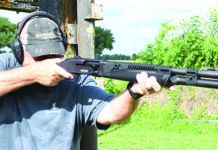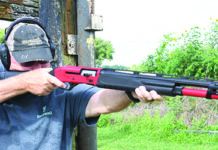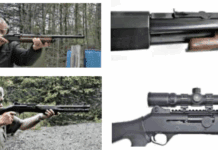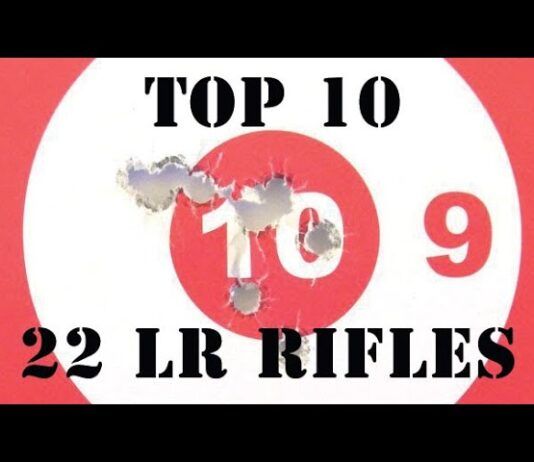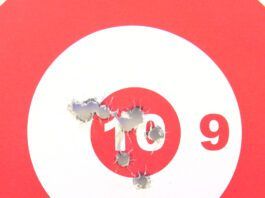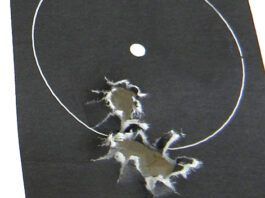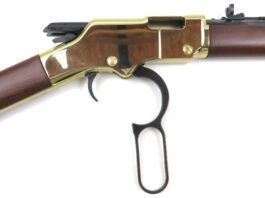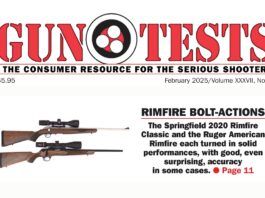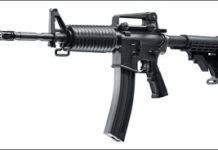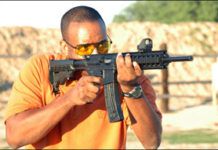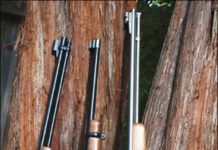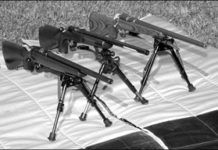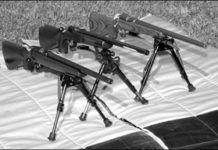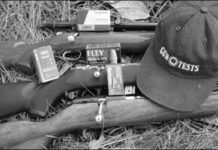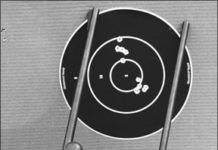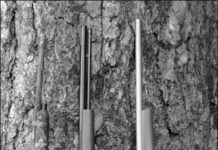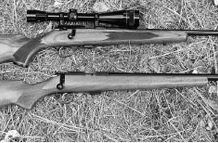Rim-Tac Rifles, Round II: The SIG 522 Edges Umarexs M4
In February 2010, we began evaluating tactical or military-style carbines chambered for the 22 LR round, and we continue to find new guns in what we call the "rim-tac" category. Previously, we looked at one AR-15 derivative, one tac-styled 10/22, and another carbine that more closely resembled a 1941 Russian machine gun. Our test guns were the Ruger SR-22R No. 1226 22 LR, $625; Smith & Wesson's M&P 15-22 No. 811030 22 LR, $569; and the Legacy Sports Puma Wildcat PPS2250S 22 LR, $550. In that test, we narrowly liked the Smith & Wesson M&P 15-22 the best, giving it an A grade compared to the Ruger's A- tally and the Wildcat's Bgrade.
Along the way, we had a heckuva lot of fun with the rifles without breaking the ammo bank. So, we gathered up two more rimfire samples from Umarex and Sig Sauer and wheelbarrowed bricks of 22 fodder to the range and had at it. Our test guns this round were the very different Colt M4 Carbine No. 2245050 22 LR, $576; and the Sig Sauer Sig522 Classic No. SIG522001 22 LR, $572.
The Colt has a complicated background. Carl Walther Germany entered into a licensing agreement with New Colt Holding Corporation, in which Carl Walther will produce these 22 rifles in Germany under the Colt brand. Umarex USA is responsible for importation, sales, marketing and service for the Colt tactical replicas.
Two tactical styles are being offered, each modeled after a Colt original—the M4 and M16 rifles—and both are available in two variations with 30-round 22 LR magazines along with a variety of accessories. The M4 version that we tested is a blowback semiauto with a barrel length of 16.2 inches (412 mm), overall length of 31.1 to 34.4 inches depending on the adjustable stock length, and iron sights, with the rear set into a detachable carry handle on a metal flat-top receiver.
Likewise, the Sig522 has lineage worth noting. According to Sig Sauer, the 522 has the "…look and feel of the Classic SIG556. Featuring SIG556 parts, including a Swiss-type folding stock and polymer forend on a durable metal receiver with integral Picatinny rail." We evaluated a 556 in the March 2010 issue, grading the 5.56mm rifle highly with an A-, but dinging it for its weight and cost.
Those aren't such factors with the 522, whose price tag is a few dollars below the M4 rimfire and whose weight is 6.4 pounds empty. Its overall length is 35.1 inches with the stock fully extended, 33.6 inches with the stock collapsed, and 26.1 inches with the stock folded.
Tactical-Style 22 LR Carbines: Ruger, S&W, Legacy Duke It Out
22 Magnums: Marlins 983S Bolt Gun Is a Magnum Bargain
The high demand and short supply of ammunition in recent months has left many rifle shooters scrambling for alternatives to their centerfire firearms. While rimfire rounds may not be the complete answer to the problem—some types of rimfire ammunition in also in short supply—the popularity of the less expensive bullets is growing.
Those shooters interested in a little more punch for the dollar are turning to 22 Magnum offerings. With more knock-down capability than a Long Rifle round and selling for at about half the cost of common centerfire ammunition, the magnums seem to be a good choice.
We selected the 22 Magnums because they can satisfy the plinking desires of firearm enthusiasts without breaking the bank; and they offer varmint-stopping punch for shooters interested in bagging small game. We selected three different actions of 22 Magnum rifles for our test, including one model that was recently discontinued and has become something of a sought-after collector's item. Each of the rifles has a dedicated fan base, with some favoring the old-style lever action; some siding with the normally more accurate bolt action; and some interested in the rapid-fire power of a semiautomatic.
The three rifles in our test were the lever-action Henry Model H001M, $420; the bolt-action Marlin Model 983S, $320; and the discontinued (2006) semiauto Ruger Model 10-22, which is selling for about $600 on several gun-trading websites. Despite the continuing drain on ammunition supplies because of volume purchases, there are still many different varieties of affordable 22 Magnum ammo available at most sporting-goods outlets.
We selected three types of ammunition for our test of the three rifles to check out the effectiveness and grouping of different loads. Our test ammunition included CCI Maxi Mag TNT 30-grain hollowpoints with an average muzzle velocity of 2,200 fps; Remington Premier Magnum Rimfire 33-grain Accutip-V rounds with an average muzzle velocity of 2,000 fps, and Winchester Supreme High Velocity 30-grain jacketed hollowpoints with an average muzzle velocity of 2,250 fps.
Our testing consisted of firing groups of five shots with each rifle at targets set up 50 yards down range, utilizing a Nikon ProStaff 4X scope. All shots were fired from a solid rest on an Uncle Bud's Bull Bag at Birchwood Casey Shoot-N-C 12-inch targets. We also fired a few test rounds with the open sights of each rifle, with the details listed below. Here's our test report:
Toss-Up: 22 WMR Bolt Rifles from CZ, Ruger, and Browning
Toss-Up: 22 WMR Bolt Rifles from CZ, Ruger, and Browning
Bolt-Action 22 Trio: Two Old, One New, All Good for Our Team
22 LR Bolt Actions: We Would Buy the Remington Model 514
Getting a greenhorn shooter to take that first step along the path of a seasoned shooter, whether the targets are at the shooting range or running around in a field, often starts with a 22-caliber rifle. Most of us old-timers have fond memories of our first 22-caliber rifle. Bringing home a mess or rabbits or squirrels; punching holes in tin cans; or just trying to shoot the smallest group on paper were all part of our marksmanship learning experience.
Some of us remember that the first scene of the Audie Murphy biographical movie To Hell and Back depicts a young Murphy using a single shot to bag a rabbit for his family dinner. Developing his shooting skills with a 22-caliber rifle proved to be very beneficial marksmanship training for the man who would become the most decorated U.S. solider of World War II.
With a goal of getting our hands on a couple of used rimfires that could fit the requirements for a beginner's rifle, we checked out the used gun rack at Dury's Gun Shop (www.durysguns.com) and came up with a Remington Model 514 and a Marlin Model 25N, both with price tags of $200.
Although the Remington is a single shot and the Marlin has a seven-round detachable magazine, both rifles feature a basic bolt action loading access to the chamber; both have open sights; and both have been around long enough to have a few fans in the rimfire club.
The Model 514 was introduced in 1948 and was discontinued in 1970, while the Model 25N is a much newer 22-caliber rifle that was introduced in 1989, and was later renamed the Model 925. Remington acquired the Marlin operation in 2007 and continues to manufacture various models of 22-caliber rifles. However, our interest was in "experienced" versions of a beginner's shooting tool and the two veteran models that would most likely be older than the beginning shooter seemed to be an appropriate match.
To maintain a level playing field, we utilized the open sights featured on both rifles, rather than install better optics preferred by veteran marksmen whose eyesight may not be as good as younger shooters.
To examine the shooting performance of the two 22-caliber rifles, we selected a variety of 22-caliber Long Rifle ammunition. Although the Remington is designed to handle Shorts, Longs, and Long Rifles, we limited our ammunition choices to Long Rifle loads in fairness to the Marlin. Our test ammunition included CCI Standard Velocity; Eley Super Silhouex; and Aguila Super SE Extra, all 40-grain solid bullets; and Punta Hueca 39-grain hollowpoints made in Argentina. The average muzzle velocity of each of the rounds is 1200 fps. Targets used in our test were the Birchwood Casey Shoot-N-C bull's eyes at 25 yards, with all shots taken from a solid bench rest.
Here's our test report:
Tricky Trio of 22 Autoloaders: Marlin Tops Remington, Ruger
Medium-Price .22 Bolt Rifles: We Pick CZ Over Remington
High-End Rimfires: We Narrowly Pick Anschutz Over Kimber
A well-made rimfire rifle will make other shooters at the range stop, stare, and sometimes drool. Some people might buy them simply to admire their beauty or impress onlookers, but we believe that no matter how good a gun looks, if it doesn't perform, it isn't worth our consideration.
We recently tested two models that fit, or perhaps define, the high-end rimfire sporter market: The Anschutz 1710 D KL Monte Carlo No. 220.2030, $1413; and the $1877 Kimber SuperAmerica. When other shooters saw these rifles at the range, they usually stopped and asked, "What kind of rifles are thooose!"
To find out if these guns shot as well as they looked, we enlisted a panel of testers that included seven teenagers (four male and three female) and three adult males. The teenagers' experience varied from first-time shooter to four years of hunting and target shooting. The adult males all had over 25 years of shooting experience of all kinds. One of the adults commented that these rifles were "too good for teenagers to shoot."
Rimfire Carbines: Rugers Handy 10/22CRR Is Our First Choice
In September 2005, Sturm Ruger announced production of a compact version of its prolific 10/22 semi-automatic rifle, $275. Christened the 10/22CRR, we ordered one immediately. When it arrived, our first impression was that this carbine was not merely shorter; it, in fact, seemed scaled down from the original design.
We couldn't help but smile at the compact 10/22's size, but the real fun began when we went shopping for additional rimfire semi-automatic carbines to fill out a test roster. We acquired a Marlin 70PSS with composite stock, $318. The Marlin carbine differed from the Ruger in several ways, not the least of which was that it can be broken down by removing the barrel for transport. Marlin refers to this model as the Papoose. Our third gun was the Armscor AK 22, $220. The AK22 closely resembles an AK47, down to the replica magazine.
All three guns arrived with a single magazine. Further, each carbine could be viewed as a youth model, a training device, or both. But would the reduction of size compromise the time-proven 10/22 design? Would the Armscor AK22's big-gun appearance interfere with function or reliability? Would the integrity of lockup between barrel and receiver of the Marlin show signs of failure after repeated applications? Could three conceptually different models produce the same level of accuracy?
To find out, we shot the guns at 50 yards using a Caldwell Tack Driver ($33 unfilled from
Here's what we found when we tested the guns head to head:
Youth .22LR Single Shots: CZ, Henry, Rogue, and Savage
We tested four rifles suitable for use by young shooters, and in two cases, our evaluators came away very disappointed.




